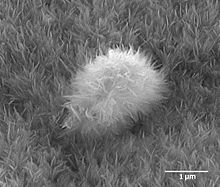Hydroxyl Apatite
Introduction
Hydroxyl apatite, also called hydroxy apatite (HA), is a naturally occuring minerals from calcium apatite with molecular formula [Ca5(PO4)3(OH)], but is usually written as [Ca10(PO4)6(OH)2]. Hydroxyl apatite is a main inorganic crystalline component in animal hard tissue such as bones and teeth. It content in natural animal teeth is 80-98% and in natural bones is over 60%. Upto 50% by volume and 70% by weight of human bone is a modified from of hydroxyl apatite. It has been proved thet synthetic HA has good properties as bio-compatible, osteoconductive, non-toxic, non-imunogenic, bioceramic.
Hydroxyl apatite can be synthetically prepared from natural source. Because bone defect arisen from cancer, injury and accident are most common in the clinic, a mass of HA are needed for restoration of bone defect.Therefore, both natural and synthetic kinds of HA are widely used as bioceramic in forms of particle, block and coating for the hard tissue repair. Synthetic HA can be prepared by means the wet and dry-method.
On the other hand, the production of HAp from natural sources is inexpensive and uncomplicated.The thermal calcination method is commonly used for the isolation of natural HAp. Tuna (Thunnusobesus) is a fish species of great commercial importance in the tropical and subtropical waters of the Pacific, Atlantic and Indian oceans. Specifically, Thunnus obesus occupies 12% of the total amount of fish production in Korea (Production Database of Ministry of Maritime Affairs and Fisheries of Korea). It is usually processed as canned food and sliced raw meat in a factory and the by-products of tuna are affluent and collected at once. The waste of Thunnus obesus has recently become a serious issue in coastal areas of Korea; one of the simplest ways to decrease pollution is the selective isolation of HAp from this waste. Ozawa et al., has reported the removal of aqueous chromium by fish bone waste originated HAp. Micro structural HAp has already been obtained from fish bone by thermal treatment , thermal decomposition, alkaline hydrothermal, sub critical water process from bovine bone, teeth and bones of pig, extracted human teeth and cuttle fish . Although much has been learned about HAp isolation from natural sources, the most important parameter, exact isolation temperature, remains poorly understood. In the present study, we have utilized Thunnus obesus bone as a new marine source for isolation of HAp and subjected the bone to various physiochemical properties, in order to find out the optimum conditions for HAp isolation. The derived HAp can be used for various medical and industrial applications and substantially increases the economical value of Thunnus obesus bone.


figure. Needle-like hydroxyapatite crystals on stainless steel